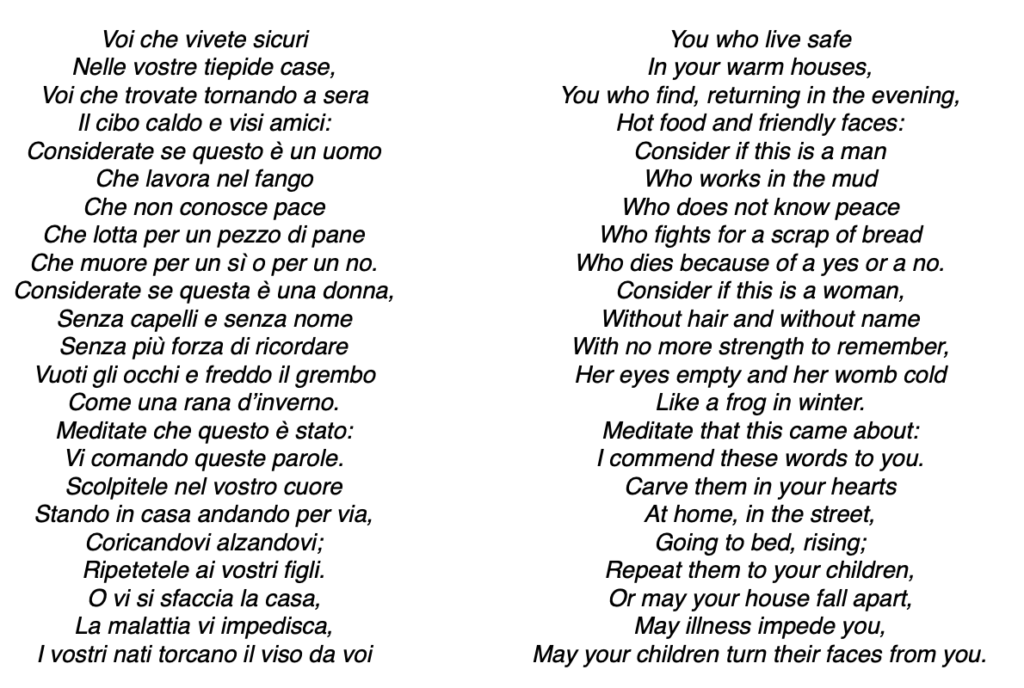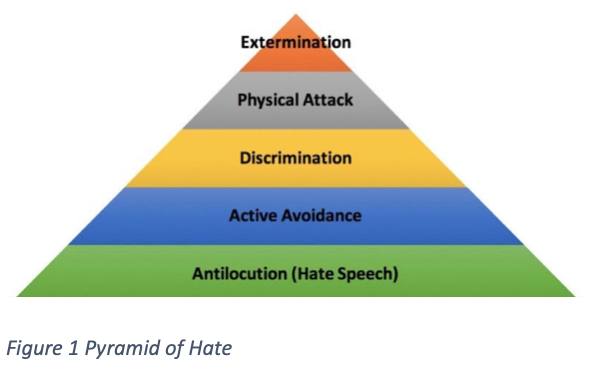by Caterina Vanin , IBDP1 – International

January 27. International Holocaust Remembrance Day. It was Primo Levi, an Auschwitz survivor and author of the poem you read above, who said “to understand is impossible, but to know is necessary and to remember is a duty.”
Several institutions, including schools, try to fulfil this moral obligation by organizing different activities, and yet it never seems to be enough.
How many Jews were exterminated during the Second World War? Where were the most important concentration camps located? Who was Adolf Hitler?
I guess all of you reading this article would be able to answer these questions, maybe not in detail, but you sure have an idea of what I am asking about.
During my International Baccalaureate, especially through my History and German lessons, I had the chance to confront myself with these and other questions concerning the Holocaust, even with questions which are harder to answer and that lead to wrongfully ignored depths of what happened. Would you be as confident to answer if I asked you the percentage of homosexuals who died in concentration camps? Could you explain what were the racial laws and against whom they were in force? And would you be able to explain the underlying reason why such terrible things happened?
Sadly, these questions are horrifically contemporary, even though most of the time it is hard for us to notice. And it is in this time that a deeper reflection is needed, not only on the historical facts, but also and especially on the moral and ethical principles which lead to the killing of millions of innocent people.
As mentioned above, everyone knows and recognizes the consequences of Nazi madness through the exponentially high number of victims in the concentration camps.
However, to truly be aware of what happened during the Holocaust it is essential to take a step back and understand how it was possible to arrive at such situation, where everyday thousands of people were taken from their homes and led to their deaths.
Indeed, the Pyramid of Hate is a useful representation for visualizing the various steps of Nazism because it helps us understand how it could escalate to such extents.

Before the extermination of minorities, brutal violence was used by Nazi forces during various physical attacks. One striking example is the Night of Broken Glass, a nationwide riot characterized by violence, persecution and vandalism which occurred on the night between November 9 and 10, 1938. Jewish communities had to endure hours of terror as Nazi Party paramilitaries set on fire hundreds of synagogues, vandalized thousands of Jewish businesses, raided homes, and arrested 30,000 Jewish men just because they were Jews. Moreover, nearly 100 Jews were killed and although many non-Jews were present as curious spectators, only a few of them actually offered help and neither the police force nor the fire brigade attempted to intervene to stop the destruction.
But how did things escalate to physical attacks towards the Jews? Once the discrimination against these people was so strong that it seemed normal to confront them with violence.
As a matter of fact, discrimination against Jews occurred through a very strict segregation and the imposition of racial laws. Only racially pure Germans would be allowed to hold German citizenship. Only a limited number of Jews could attend schools and universities. Jewish lawyers and notaries were not allowed to work on legal materials. Jewish doctors could only treat Jewish patients. Jewish actors were not allowed to perform on stage or on television. “Forbidden for Jews” signs hung in many doors of shops, libraries, and museums.
Moreover, the step even beneath discrimination and active avoidance and which many address as the first leading to extermination was antilocution, which implied that a whole series of attitudes, behaviors and prejudices were spread by propaganda in society putting Jews and other minorities in a bad light and making them the scapegoats of the German regime.
Now you may wonder: why was there no opposition at the basis of the pyramid? Why have only a few tried to report this unfair treatment from the start? In my opinion it is because under the step of antilocution lies another layer, a larger layer that both in the times of Nazism and today applies to the great majority of the population. This step is called indifference, and it is a pathologically innate condition of human nature that pushes us to think only about our own well-being and that of our family.
A clear example of this negligence was Liliana Segre’s primary school teacher, who, when the racial laws were approved in Italy, went to Liliana’s house and, without any compassion, told her that she could no longer go to school and that as teacher she couldn’t do anything because she wasn’t the one imposing the regulations.
This behavioral characteristic is a major problem for a population which is so passive, so unwilling to make its voice heard by the institutions, so not outraged by the propaganda, that becomes nothing other than an excellent medium through which hatred and brutality spread, causing in the long run the development of disastrous situations.
And now that you are reading this article in your warm houses, you who find, returning in the evening, hot food and friendly faces:
Consider if this is an attack, lifeless bodies lying all over the peaceful Kibbutz, whole families killed while trying to hide, executions of disarmed civilians in their own houses, brutally slaughtered infants.
Consider if this is a counterattack, denying a whole population access to food, water, and medicaments, bombarding 33% of the Gaza Strip, killing around 23,000 people including a vast majority of innocents.
Meditate that this is happening right now.
When Primo Levi told us to consider and meditate what came about, he was trying to fight indifference. He was trying to prevent history from repeating itself by mining the very foundation on which pyramids of hate can be built. He hoped for a future without atrocities. Now though, that such monstrosities are happening we can see how the fight against indifference is really the hardest fight.
But we shall never stop fighting, we should go even beyond considering and meditating: we have to take action.
It is a must that we inform ourselves through reliable news sources, that we share our opinions with compassion and respect, and that we support local and global initiatives that promote a peaceful world for everybody.
Only through these simple steps we will become responsible citizens. Citizens who recognize the power and value they have in society. People who, united, can and want to make their voices heard and who believe that advocating for change is necessary for the present and future well-being of each individual in this earth.
So, consider, meditate, take action.




 International Holocaust Remembrance Day: Why do we need to commemorate the Holocaust?
International Holocaust Remembrance Day: Why do we need to commemorate the Holocaust? 



Lascia un commento